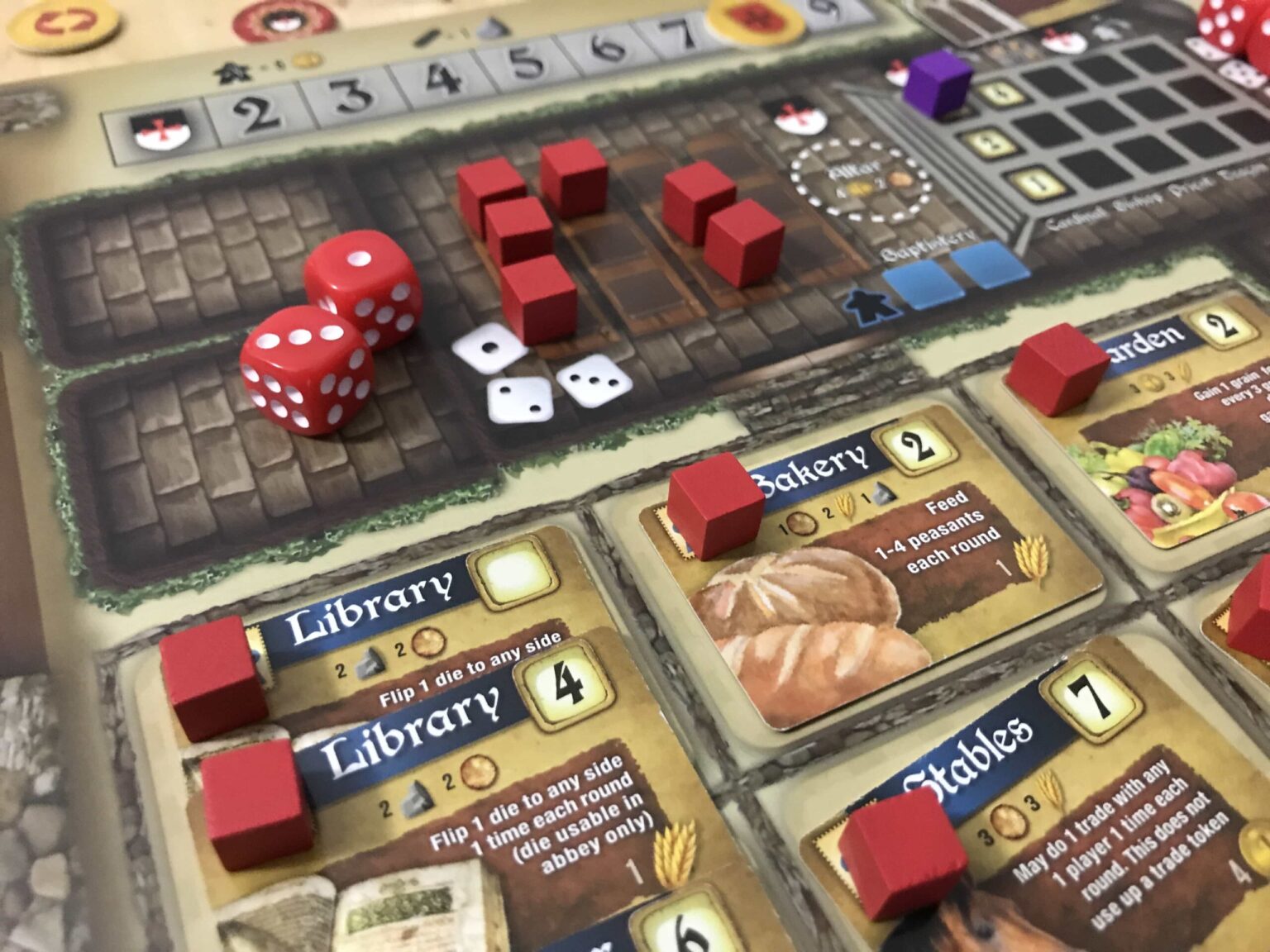It’s a dark time – one of disease, pestilence, and death. The Dark Ages settled over Europe like a cold, wet blanket, dousing aspirations, and leaving behind shivering peasants, just happy to be alive. So, you know, it wasn’t a great time.
Games set in that period can be one of two things – they can either be a reminder of just how horrible it was to be alive, or they can give us a glimpse at the people and efforts made to make things better. This is one of the latter, and highlights the efforts involved in overcoming all that murk and depression to build something truly great.
In the King’s Abbey is about creating something greater, working on behalf of King Sivolc to build a great Abbey the likes of which the region had never seen before. And how do we build such an epic edifice? We roll dice and place workers! How else?
How The King’s Abby Plays
The King’s Abbey is not a simple game. The rules are intricate and there are a lot of moving pieces, a lot of fiddly bits, and a lot of things you can easily skip over or miss. Just take a look at this pile of components:
With my big, meaty hands, those bits are a quick formula to a frustrating experience, so I whipped out my Treasure Chest for a component upgrade. I recommend the same:
Once you get everything on the table, players will take their own boards, along with ten dice (representing monks), and a handful of starting resources. The goal of the game is to roll those dice and assign them to various spaces on the main board to gather resources and build up their abbey. These actions include things like gathering resources, building buildings, training new clergy, bringing in peasants, and preparing defenses against the “darkness”.
The interesting part of this process is the balance between bringing in peasants and training clergy, and gathering the resources needed to build. You will also be assigning your dice to crusade cards, which will hold those dice until the crusades are completed. As a result, you must carefully manage when to use your dice and how to assign them.
Winning the game is about Prestige, which you gain by completing those crusades and building different towers and new buildings in your abbey. You have seven rounds, and in those rounds, you’ll face “darkness” events in the form of depression, raiders, and famine – randomized each game by a deck of cards.
It sounds like a lot, and at first it really is. There are a lot of different types of bits, you’ll be storing both on your player board and on the main board. Then there are building cards, events, crusades to manage, and the darkness tracker for which your defenses need to be ready. Combined with the immense amount of tracking you’ll be doing from the special abilities and bonuses on the buildings you build, there’s a lot to keep track of, and it’s easy to accidentally skip a bit or get lost in a round without the summary card in front of you.
What We Like About King’s Abbey
We received our review copy of King’s Abbey way back in May and played it almost immediately. Why then has it taken so long to get this review up? There are a couple of reasons.
To start, the game is not a quick teach. There are a lot of rules here, a lot of fiddly bits, and a rule book that covers several different situations. For a worker placement game with dice, it manages to pack a surprising amount of depth into the flow of the game, without it necessarily being a heavy game. In the end, it’s still just a gather resources, spend resources, activate abilities game.
The problem we initially had with the game is not that it’s a brain-burner, but that it took a fair amount of time to nail down all of those different rules and to play through the game. It’s a long one – so much so that the first time you play, the rulebook will recommend you shorten it to just 5 rounds. The full seven rounds with a full complement of players is a long game.
Here’s where the game’s charms come in. There are a lot of different things you can do. You can focus heavily on crusades, you can fill your building slots early, or you can build up your defenses and benefit from both protection against the darkness and gain prestige. The addition of the raiders which creates a semi-cooperative threat that everyone needs to be prepared for is an interesting one as well, and because it’s not set in stone when they will come, it’s something everyone needs to be prepared for.
There are some interesting puzzle-mechanics here as well with the trade tokens and the ability to work out in advance where each of your dice will be placed. This is especially fun in lower player count games where you have a greater number of options.
What We Didn’t Like About The King’s Abbey
With all of that said, there are a number of issues here that need to be highlighted. To start, the game is too long and too complex. I know I already mentioned that, and in some ways, these things can be good, but in reality, it overstayed its welcome in most plays.
With 12 different phases to keep track of in every single round, and 7 full rounds, you’re looking at 84 unique phases throughout the game and a good 3-4 hours to get through with teaching – a bit too long for a game that borrows mechanics from lighter weight games.
Then there are the components. Because of how much is here, everything is too small. The cardboard bits are tiny and easy to get lost, the cards are tiny and hard to read, and there are far too many things on the board and your player board at one time.
The combination of a fiddly game in general and a linear play style that has most players doing roughly the same things with their actions, means the game doesn’t feel as fully refined and tightly managed as some other games with very similar mechanics.
The Bottom Line
The King’s Abbey is a good game with a fair number of issues. The small components, overabundance of things to keep track of in any given turn, and the long play time are all issues that you’ll need to content with. But despite these issues, the combination of a large pool of dice, ample options, and a puzzle-like approach to worker placement is both interesting and engaging in most cases.
For players who enjoy intricate euros with a lot of different pieces and a decent implementation of theme will find a lot to like with The King’s Abbey. For players seeking a medium weight game that doesn’t overburden players with excess tracking, it’s not as strong of a game.









